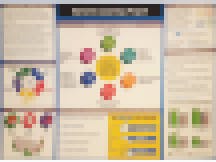“Instructional coaching is like sports coaching,” says Teresa Engler, K-12 Instructional Technology Coach for McGuffey School District in southwestern Pennsylvania.
“From the sideline, a coach gives the team a play, explains how it will work in the field and then watches as the players execute. The coach then huddles up with their team to talk about whether the play was successful, and then guides players through how to approach future situations,” she explains.
Engler represents one of 32 school districts across 10 states that took part in Digital Promise’s Dynamic Learning Project (DLP) pilot program that supported school-based instructional technology coaches with professional development, mentoring and data over a three-year period. She is also a Google for Education Certified Coach and firm believer in the power of coaching.
“I wish I had a coach in my long career as a teacher because there were times I felt like I was struggling and if I just had the support of a coach next to me, I would’ve been able to be a little braver, try to do more things or been just a little more confident in what I was implementing in my classroom,” she reflected. “Having a coach would have made a significant contribution to the quality of my teaching—expanding what my students learned from me.”
A growing body of research confirms her theory, showing instructional coaching to be more effective for teacher growth than traditional forms of professional development.
Here, we spoke with Engler about her experiences as a coach with the Dynamic Learning Project and how the program helps bolster teacher professional growth and student learning.
EdSurge: What do you do as your district’s instructional technology coach?
Engler: I offer K-12 teachers professional learning experiences on a personalized level. This includes opportunities to work on challenges specific to their experiences and selecting strategies that lead to enhanced instruction, with or without technology depending on the situation. I meet regularly with teachers and do classroom visits to help implement those strategies.
How has COVID-19 school closures and the shift to remote learning changed how you support your teachers?
Right now, I feel like I'm on-call and in demand—not on a regular cycle with scheduled formal meetings. In the beginning, we went from zero to 100% online learning in such a quick time that our heads were spinning. Coaching became instantaneous. Teachers requested my assistance as-needed and I became very instrumental to the continuity of instruction. School leadership really looked to me for a plan because we had to move to remote learning so quickly.
Remote teaching is new to a lot of teachers, so many of them asked me to test the tech and lessons before they actually did it with their children online. I’ve also stepped in to facilitate meetings with students or demonstrate lessons to classes, in addition to meeting virtually with teachers to collaborate on personalized teaching strategies.

I was also asked to help parents with the transition online and to offer resources and support for everyone—students, paraeducators, administrators as well as teachers. It just became clear that more people needed support and I was in an ideal position to help.
How much did your school change after taking part in the Dynamic Learning Project?
I love talking about this because we had an administration with a vision. When I was asked to be this coach, they were very supportive and eager to get me on board because they believed in the coaching process. That's very important. Like a lot of other schools, we had existing devices and tech resources, but many were outdated and not being fully utilized. Our administration had the vision to systematically lay out a plan about how we were going to rotate and update the tech on a schedule. We needed and got that leadership from the administration.
In classrooms, the coaching program gave teachers the support they needed so they could put the best practices they learned into action. Once that all happened, we saw other systematic changes in the district, like ordering more devices for students, making technology more accessible for teachers and bringing more professional learning opportunities in.
Were there any assumptions that you had at the beginning of the project that changed as you progressed?
Yes, absolutely. In the beginning, I thought my role as tech leader was limited to assisting teachers with their day-to-day issues with technology, essentially being technical assistance and a resource-gatherer.
When I became a coach and went through the Dynamic Learning Project, I had my eyes opened wide to how I could be so much more—literally the supportive coach on the sideline giving my teachers plays to run with their students and then reflecting on that process later to see if it was successful or not.

The non-evaluative component of coaching is so important because you build trust and these solid relationships with your teachers where you can bounce ideas off of one another in a safe zone. You can also talk about other things that are coming into your classroom, like “I had a rough morning,” or, “I'm not feeling well,” or, “I'm having class management issues,” and that’s when you start to really dive deep into how coaching can be very powerful. Once you tackle some of those smaller challenges, it frees up the teacher to try bigger things like using new technology in their teaching.
How does coaching support other professional development efforts?
When you go as a teacher for professional learning, you may take a lot of notes and gather up all of the materials, but you're not always going to implement it when you get back to your classroom. When you have that coach standing right next to you, you might say, “Hey, I learned this at a PD session. Would you help me try this out?” You have a support system so if it doesn’t go well, you can try again with the support of that coach, or if it succeeds, the coach can find other ways to enhance the lesson or you can continue forward with more PD.
What’s best developed by coaching versus traditional forms of PD?
First, personalized professional development can’t be beat. That one-on-one, tell-me-what-you-need, on-demand, personalized learning is so important and immediately has an impact.
The culture of collaboration that is created also affects the entire school culture. The trust and camaraderie that is built opens up space for freer conversations and exploratory sharing at grade level and department meetings. You end up changing how all professional development is seen and utilized. Coaching transforms how teachers learn, and that translates into better teaching. It also helps with teacher retention because when teachers are feeling supported, teachers feel successful. It creates a positive work environment.
What do schools need to create a strong coaching program?
The Digital Promise Instructional Coaching Playbook is a must-read because it shows you step-by-step how to develop and sustain an effective coaching program, so start there. You also need to have a supportive administration. If you have that, then both coach and teachers have the time to allocate to coaching, meetings and collaboration.
When administrators develop a deep understanding of the coaching process, they can then do the important work of clearly defining the role of the coach for their schools. This not only supports the coach but articulates a clear vision for the program's success. It lets teachers know what coaching is and how it can positively influence their teaching to enhance student learning.



